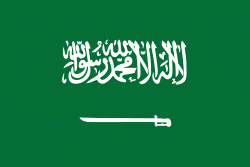Al-Qassim Province (Al-Qassim Region)
Al-Qassim has the lowest share of population living below local poverty line in Saudi Arabia. It is the seventh most populated region in the country after Jizan and the fifth most densely populated. It has more than 400 cities, towns, villages, and Bedouin settlements, ten of which are recognized as governorates. Its capital city is Buraydah, which is inhabited by approximately 60% of the region's total population. The governor of the province from 1992 to 29 January 2015 was Prince Faisal bin Bandar, succeeded by Prince Faisal bin Mishaal.
Al Qassim also "Al Gassim" "Gassim" derived from the word "Qassimah" (قصيمة), a reference to قصائم الغضا, meaning the region's sand dunes from which the white saxaul trees grow. The region has a large population of Calligonum comosum plants, a woody shrub known as arta.
Map - Al-Qassim Province (Al-Qassim Region)
Map
Country - Saudi_Arabia
 |
 |
| Flag of Saudi Arabia | |
Pre-Islamic Arabia, the territory that constitutes modern-day Saudi Arabia, was the site of several ancient cultures and civilizations; the prehistory of Saudi Arabia shows some of the earliest traces of human activity in the world. The world's second-largest religion, Islam, emerged in what is now Saudi Arabia. In the early 7th century, the Islamic prophet Muhammad united the population of Arabian Peninsula and created a single Islamic religious polity. Following his death in 632, his followers rapidly expanded the territory under Muslim rule beyond Arabia, conquering huge and unprecedented swathes of territory (from the Iberian Peninsula in the west to parts of Central and South Asia in the east) in a matter of decades. Arab dynasties originating from modern-day Saudi Arabia founded the Rashidun (632–661), Umayyad (661–750), Abbasid (750–1517), and Fatimid (909–1171) caliphates, as well as numerous other dynasties in Asia, Africa, and Europe.
Currency / Language
| ISO | Currency | Symbol | Significant figures |
|---|---|---|---|
| SAR | Saudi riyal | رس | 2 |
| ISO | Language |
|---|---|
| AR | Arabic language |















